
Over 30 years ago, then-New York Governor Mario Cuomo gave the keynote speech at the Democratic National Convention. In an address that would become the clarion call for progressives throughout the nation, Cuomo fiercely critiqued the rosy optimism of President Ronald Reagan, who had recently characterized America as a "shining city on a hill," where no citizen needed to fear for their families and their futures. Such a view, Cuomo argued, missed the other, less-brilliant side to this city, where poverty was increasing daily, families were struggling to pay their mortgages, students couldn't afford to pay for their own educations, and the elderly wondered whether their last years would be characterized by penury and hardship. Thirty years later, Governor Cuomo's speech still speaks to the inequalities and injustices that still make America more a "tale of two cities" than a single "shining city on a hill," particularly for Latino Americans who continue to struggle to recover from the devastating Great Recession.
"There are more poor than ever; more families in trouble," Governor Cuomo warned in 1984 that, the success of the rich notwithstanding, poverty was increasing and that too many American families were finding it difficult to support themselves. Sadly this state of affairs remains true today. Census data from 2013 shows that one-in-six Americans live in poverty. And for Latinos, things get worse -- one-in-four Latinos are counted as poor, living on incomes of less than $23,283 for a family of four. While the overall economy has continued to gradually improve since the Recession, these gains have not trickled down to Latino working families, whose incomes remain flat even as the national GDP steadily grows. In the midst of this wage stagnation, Congress has been steadily assaulting those very safety-net programs that kept millions more working families from experiencing the worst effects of the Great Recession. Governor Cuomo's words from 30 years ago remind us that we cannot be tricked into equating macro-economic growth with the well-being of middle- and working-class families.
"Students can't afford the education they need," Governor Cuomo lamented to the Democratic Convention. The stark fact is that nearly-insurmountable barriers to educational achievement exist for Latino students today. Latinos possess the lowest educational attainment levels of any ethnic group in the United States. Why? In large part, it is because the cost of education has increased year after year, to levels that are simply unaffordable for the average family. College tuition and fees have risen by 1,120% since 1978, with average in-state tuition at public colleges standing at $8,893 and the average tuition at private schools skyrocketing to $30,090. Meanwhile, the median household income for Latinos in 2012 was only $39,005. For those Latino students who are able to somehow overcome these financial obstacles and make it to college, most are forced to take on enormous amounts of debt. Of the Latino students who graduate college today, two-thirds leave with student-loan debts of over $25,000. With little opportunity to pursue higher education without bankrupting themselves, Latinos are left with very few options to advance themselves and their families.
Cuomo protested that "There are elderly people who tremble in the basements of the houses..." The Great Recession took a toll on most Americans' household savings, but Latino wealth and prospects for a secure retirement were particularly-hard-hit. While whites overall increased their household wealth from 2001 to 2011 by a small percentage, the gains of which went to the richest 60% of white families, Latino families lost 42.1% of their net worth during this same period. The future doesn't look much brighter for the next wave of Latino retirees: 69% of Latino working families have no savings in a retirement account, compared to 37% of white households without retirement assets, and only 38% of Latino workers age 25-64 have access to employer-sponsored retirement plans, as opposed to 62% of white workers in that age range. The elderly people "who tremble in the basements of houses" in 2015 will be largely elderly people of color, whether black or Latino, who have been devastated by economic downturn and inadequate policy responses to continuing inequalities of wealth and income.
Governor Mario Cuomo died this New Year's Day at the age of 82, leaving behind a lifetime of dedicated public service and a legacy of calling on America to live up to its promises of opportunity and justice for all. Thirty years after his stirring address at the Democratic Convention the facts strongly suggest that we still dwell in a "tale of two cities," where one part of the "shining city on the hill" gets richer and more powerful while another, less prosperous side of the city sees its ability to secure a livelihood and its hope for the future eroding away each day. Particularly in the Latino side of the American city on a hill, Governor Cuomo's call for a renewed commitment to social justice and equal opportunity for all Americans rings more urgently than ever. It's time for our government to respond to Mario Cuomo's incisive critiques of an American elite that leaves the poor, young, elderly and Americans of color on the darker and dingier side of the shining city on the hill.